Charles Sobhraj, convicted murderer, has a new story to tell
After spending 19 years in a Nepali jail, ‘the Serpent’ says he plans to sue for his imprisonment and chase series deals.
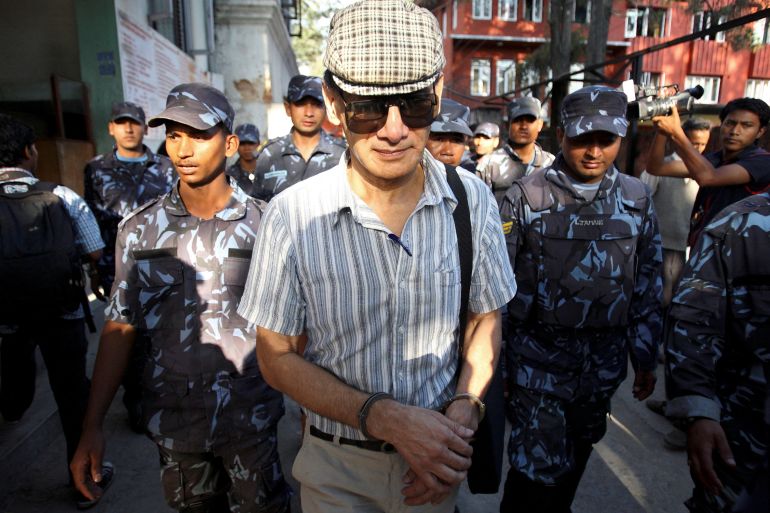
Late last year, after spending 19 years in a Nepali jail, 79-year-old convicted murderer Charles Gurmukh Sobhraj was revelling in his new-found freedom. The day after Christmas, a text message from Sobhraj landed on my phone, sent from a hotel in Paris: “It’s 6am and I am in my first bathtub since many years. Feels so nice.”
A few hours later, a picture of his Boxing Day breakfast arrived: three types of cheese, salami and prunes on a white plate next to a cup of black coffee. “Have breakfast,” he wrote.
Keep reading
list of 4 itemsKey takeaways from 12th day of Trump’s New York hush-money trial
Mexicans protest and pay tribute to murdered foreign surfers
Bodies of murdered Australian, US surfers identified in Mexico
Three days previously, Sobhraj, a French citizen, had been released from Kathmandu Central Jail where he had been imprisoned for the murder of two backpackers in 1975.
It was not his first time in prison. Sobhraj has spent more than 40 years in different prisons, including in Athens and Tehran, and 21 years in India on charges including murder. It was during his time in Delhi’s high-security Tihar Jail in the 1990s when I first met Sobhraj. Back then I was a crime reporter in the Indian capital and would often interview him.
In the 1970s, Sobhraj stalked the “hippie trail” in Asia befriending young, unsuspecting, Western backpackers to rob them of their passports and money after spiking their drinks and meals with laxatives and sleeping pills.
Sobhraj would use his victims’ identities – names and passports – in one country to travel to another where he would commit more crimes and continue the pattern, creating a maze of stolen, shifting identities. Dubbed “the Serpent” for his ability to evade the authorities in different countries, Sobhraj has been linked to more than 10 murders in Nepal, India, Pakistan and Thailand, and is suspected of more, but has been convicted of just two.
His story and his crimes, mostly committed between 1970 and 1976, have fascinated the media and been the subject of bestselling books and the 2021 eight-part Netflix-BBC series, The Serpent.
Now a free man, Sobhraj has been busy trying to sell his story.
His memoir and a documentary on his life have been released. He won’t say how much he was paid for his memoir but says he plans to travel the world with a camera crew to record a series on his life, and is basing himself in London as he negotiates contracts for series and films. He also says he plans to sue all those he feels have wronged him.
But those who have followed his crimes, including a Nepal police official and a German former senior United Nations official who helped secure an international arrest warrant for Sobhraj, see these plans as part of a new chapter in a familiar story of manipulation.
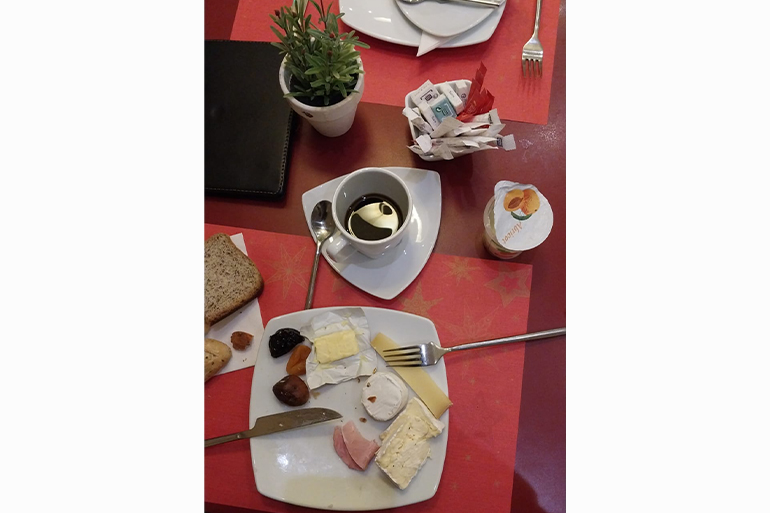
‘We are going to sue’
In Kathmandu, Sobhraj had been serving a 20-year life sentence for the murders of Connie Jo Bronzich, a 29-year-old American radiology student, and Laurent Carriere, a 26-year-old Canadian backpacker and seasonal miner.
Although Bronzich and Carriere were murdered in 1975, it would take 28 years for Sobhraj’s arrest in 2003 and subsequent conviction.
After undergoing cardiac surgery in jail, in 2019 Sobhraj began petitioning Nepal’s Supreme Court for early release on the grounds of age, health and good conduct – no crime committed while in custody. The order for his release came last year on December 21.
In a phone interview on Christmas Day, speaking from the noisy lobby of a three-star hotel in Paris, he told me, “I have never killed anybody in my life.” His tone was characteristically even as he added: “I have taken passport, used passport, stolen some money. But I’ve never killed people.”
Sobhraj alleges that he was framed for the murders and that he never entered Nepal before 2003. He claims that he is a “victim” of what he says is a corrupt criminal justice system.
“We [he and his lawyer Isabelle Coutant-Peyre] are going to sue the state of Nepal before the UN Human Rights Committee,” Sobhraj told Al Jazeera.
“We are going to sue Netflix and BBC for The Serpent because they have made the series on the basis that I’ve been convicted in Nepal in two murder cases, therefore I am a serial killer,” he said.
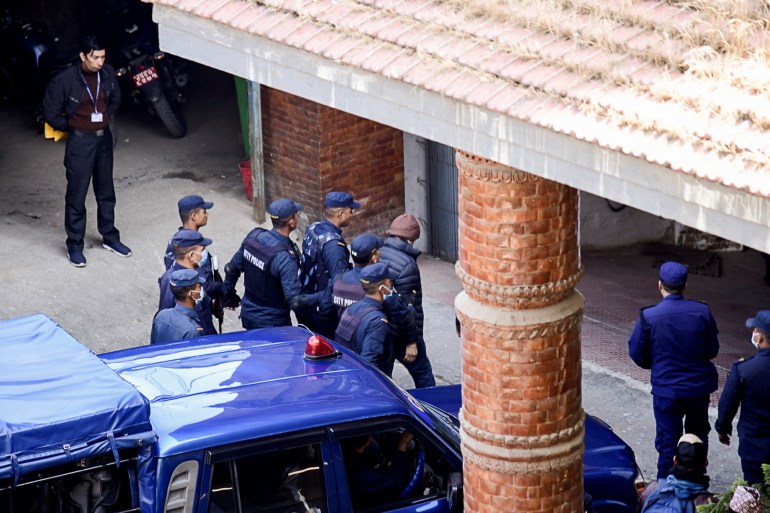
‘A great part is fiction’
Sobhraj’s memoir, Moi, le Serpent (Me, the Serpent), published in French by L’Archipel, was released in February, and its translations into other languages, including English, with the title, The Memoirs of The Serpent, will be released soon. A 90-minute French documentary, Sur la piste du Serpent (On the Snake’s Trail), has been released in some French-speaking markets, including France and Canada.
The story that Sobhraj advances in his memoir and the documentary is that he’s not a killer, but a smuggler and gems dealer who drugged and robbed people, and a criminal with a massive network of contacts whose assistance has often been sought by intelligence agencies, politicians and security operatives.
This stands in contrast to Richard Neville and Julie Clarke’s 1979 book The Life and Crimes of Charles Sobhraj where Sobhraj claims he was a paid assassin for a smuggling ring for drugs, diamonds and arms involving Chinese Triads, and his victims were amateur or rival drug “couriers”.
French director Jean-Charles Deniau, who made the documentary with Sobhraj’s collaboration, told me last year that in it “Sobhraj answers questions” about his crimes and claims.
“Not all of what he says is true … a great part is fiction,” said Deniau, who had been working on the documentary since 2005. (Disclaimer: Deniau also interviewed me for his documentary.)
Deniau also edited and co-wrote Sobhraj’s memoir, where he interjects to offer context or his point of view. “After all these years, I still don’t know who Charles Sobhraj really is and what he continues to stubbornly hide,” he writes.
“Stories like this [about Sobhraj] get eyeballs. People read them, they like to watch it,” said Angela Kane, the former UN official who worked with her then-husband, the retired Dutch diplomat Herman Knippenberg, to gather evidence against Sobhraj in the 1970s.
“I think this is what he is trying to do now – he is basically trying to capitalise on his notoriety,” Kane said. “Crime should not pay.”
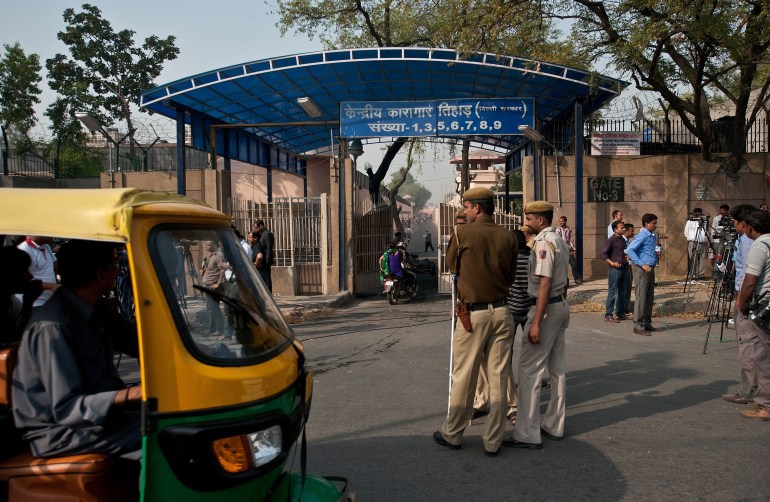
An unreliable source
I was on the crime beat with a newspaper in Delhi when I first met Sobhraj in the mid-1990s.
Sobhraj, something of a celebrity criminal, always made front-page news and was a source of information for many journalists, including me, about the goings-on inside Tihar Jail, where he was lodged between 1976 and 1997. He was arrested for drugging 60 French tourists and was sentenced to two years in prison for this crime, as several other cases were brought against him including robbery, more druggings, murder and later, a brazen jailbreak. He was cleared of robbery and the other druggings, and found guilty of and sentenced to prison for the murders of an Israeli named Alan Aaron Jacobs and a Frenchman named Jean-Luc Solomon, but later acquitted.
Apart from the many criminal cases filed against him, Sobhraj also filed several cases against jail officials, alleging mistreatment and corruption. His court outings, therefore, were regular and often long.
Sobhraj would arrive for his court appearances looking like a scholarly professor – lean and bespectacled, wearing a flat cap, suede shoes and a pen in the pocket of his collared shirt. He had a sharp memory, followed the news, and read judgements, books on law, psychology and criminals.
Sobhraj always reacted to accusations and probing questions not as an accused, but as an agitated defence attorney, focusing on discrepancies in timelines, the minutiae that didn’t tally and technicalities that could be grounds for acquittal. He would, at times, argue his own cases in court. And at least once, when a murder case was not going well for him, he launched a fast unto death to protest against the injustice of India’s justice system.
Articulate and pleasant, but with piercing eyes which never smiled, he would freely chat with journalists and, knowing what they wanted – scoops – would drip-feed information to them. He always had a story to tell, and in all of them, he cast himself as a crusader for justice. This distraction helped him avoid conversations about his own crimes and victims.
I would interview him frequently at his court outings and he would often call me with news from a mobile phone he had managed to acquire in jail.
At times, he provided accurate information about high-profile prisoners, but when it came to telling stories about himself – he was often an unreliable source.
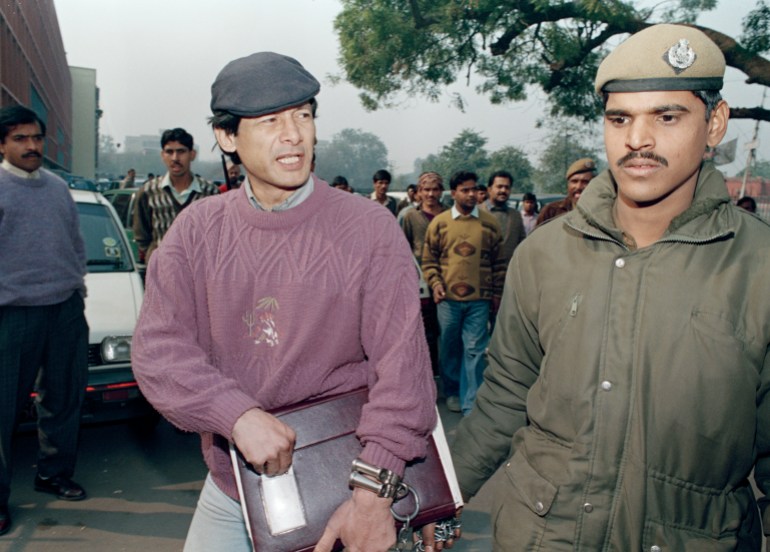
‘King of Tihar’
“He could read every individual’s psychology and would understand exactly what they wanted. If he figured that an official is honest, he would file false cases against them and extort money to withdraw the case,” recounted Sunil Gupta, who held various positions in the Tihar Jail administration from 1981 to 2016 and co-wrote the 2019 book Black Warrant which offers an account of high-profile prisoners and lawlessness inside the prison.
The cases Sobhraj filed against jail officials were for extortion and beatings which he claimed he and other prisoners were subjected to in Tihar, as well as his solitary confinement. But the truth was that he barely spent time in his 12×10-foot (3.6×3-metre) cell. He would move around the jail freely, enter administrative offices, often without permission, and there were also reports about a gang he had formed with some other inmates. They would sell drugs and liquor to prisoners, bribe officials, collect money on their behalf and beat up inmates who objected. A newspaper termed Sobhraj “King of Tihar”.
“He had many girlfriends and often he would meet them in the chambers of jail officers. [After that] he would let jail officials spend time with his girlfriends. These women would record conversations with officials and Sobhraj would use these recordings to blackmail the officials,” recalled Gupta, who referred to Sobhraj as a “master cheat” who thrived on manipulating people.
By 1986, Sobhraj, after managing to get the guilty verdicts against him in both murder cases overturned, had no pending cases and his jail term in India was coming to an end. A New Delhi court had cleared his extradition to Thailand where he could face the firing squad for the murders of a Dutch couple and an attempt to murder two Australians. He needed to dodge that bullet until the 20-year statute of limitation kicked in.
It was Sobhraj’s well-oiled network and clout in Tihar Jail that helped him pull off an audacious jailbreak on March 16, 1986, by distributing sedative-laced sweets to the guards which he had reportedly tested on a cat in the prison the week before. Sobhraj escaped along with 11 other inmates but was arrested in Goa on April 6, his birthday, and returned to Tihar.
Sobhraj remained in jail for another 11 years, facing trial for the jailbreak. By the time he was released in India – having already served the maximum term of 10 years for such a crime – and deported to France in 1997 at the age of 53, the cases in Thailand had lapsed, his hair was thinning and, ever vain about his looks, hair-grafting was on his mind.
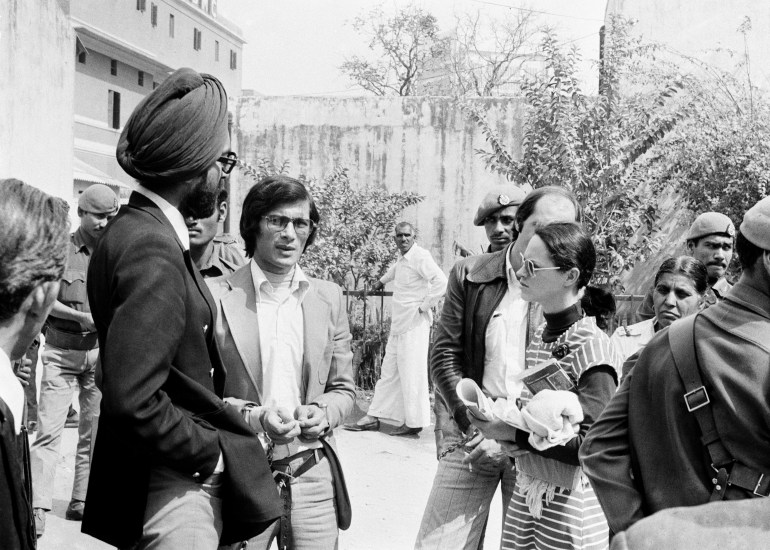
‘Taken in by his personality’
Before his years inside Tihar, Sobhraj had in the 1970s carried out druggings, robberies, murders and prison escapes. His crime trail, which began in France, coursed through Greece, Turkey, Iran, Afghanistan, Pakistan and India, before he set up his base in Bangkok, Thailand.
Sobhraj, who is of Indian and Vietnamese descent, operated under the alias “Alain Gautier”, a gem dealer. He wore silk shirts and carried a crocodile-skin attache case he had stolen in Singapore and was accompanied by his Canadian girlfriend Marie-Andree Leclerc who posed as his wife “Monique”.
“He was kind of a man of the world, meaning that he spoke languages, he was ‘established’, because he had a wife, as he said, and he was a gem dealer. Gems, of course, are always attractive to people, they think they can get a special deal, maybe a little bit more cheap … And so these young people that he befriended, they were taken in by his personality and, I hesitate to use the word, but maybe a little bit of glamour that he had,” Kane told Al Jazeera in a phone interview, speaking from her home in Vienna, Austria.
“As long as I can talk to people, I can manipulate them,” Sobhraj had told Neville and Clarke.
Sobhraj mostly targeted white backpackers who were carrying money they had saved for months of travel to places that were far from their homes. He targeted people in countries like India, Nepal and Thailand where the bureaucracy was labyrinthine and corruption was rampant.

In December 1975, Sobhraj and LeClerc had travelled to Nepal on the passports of two Dutch backpackers in their twenties, a secretary named Cornelia Hemker and Henricus Bintanja, a PhD chemistry student, after Sobhraj, along with a male accomplice, allegedly murdered them in Thailand. Hemker and Bintanja were still alive when they were doused with petrol and set on fire.
Less than a week after Sobhraj and LeClerc’s arrival in Kathmandu, the burned bodies of Bronzich and Carriere bearing knife wounds were discovered on the outskirts of the city.
An Australian woman staying at Bronzich’s budget hotel remembered her meeting a “Vietnamese-looking” gem dealer in Kathmandu. Sobhraj was questioned by the police. Days later, he escaped to India by road. The following spring, with the help of Knippenberg and Kane, who were based in Bangkok, the Thai police and Interpol would issue an arrest warrant against Sobhraj and his accomplices for four murders. With the help of Interpol and evidence gathered by Knippenberg and Kane, Nepal police registered a case against Sobhraj for Bronzich and Carriere’s murders.
Nepal has no statute of limitation in murder cases and in 2003, six years after Sobhraj’s release from Tihar, the 1975 murders in Nepal would catch up with him because he would make what he describes in his memoir as “a fatal error”; he would travel to Nepal.
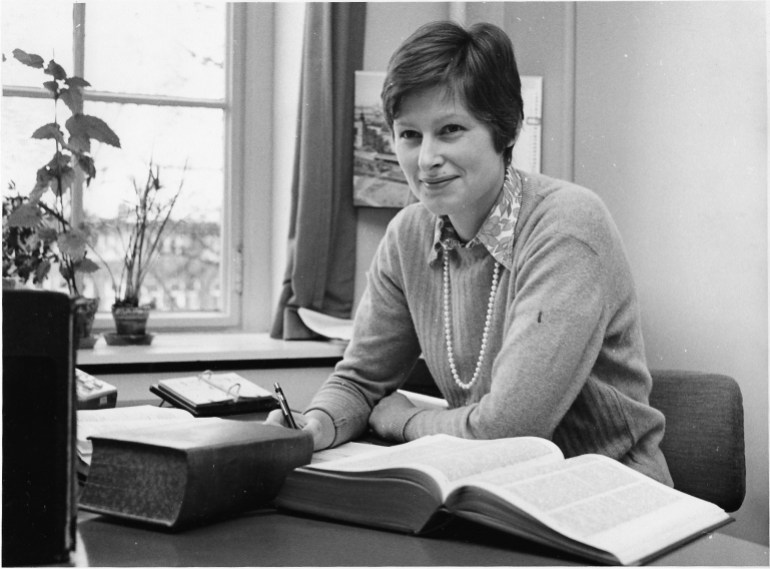
‘He wants to make big money’
It remains unclear why he returned. Sobhraj told me he wanted to make a documentary about handicrafts. In his autobiography, he writes that he travelled to Nepal as “part of my intelligence activities”. Journalists and police officials who have followed his story over the years suggest he could not bear to be out of the news cycle. Deniau, in the memoir, writes, “If he returned to the sad banality of everyday life, it would be a tragedy for him.”
Back in Kathmandu, Sobhraj was spotted by a reporter in the main tourist area and arrested a day after the publication of a front-page story in The Himalayan Times with the headline, “The Serpent living incognito in Thamel”.
Nepal police were sure they had the right man, but locating decades-old files was going to take time. “We could not keep him in illegal detention. We needed to keep him in legal remand. So the first charge we filed was an immigration case,” Ganesh KC, former deputy inspector general of police in Kathmandu and the chief investigating officer for Bronzich’s murder case in 2003, told Al Jazeera.
A case was filed against Sobhraj for entering Nepal in 1975 on the forged passport of Bintanja. And once the paperwork was ready, he was charged and put on trial for the murders of the two backpackers.
Sobhraj maintained throughout the trial that he had never visited Nepal before 2003.
“Fact is one thing, what he says is different,” said Ganesh KC.
The similarities between Sobhraj’s signature in the guest registers of the hotels where he stayed in 1975 and in the French passport on which he had travelled to Nepal in 2003 were presented as evidence. He was convicted of Bronzich’s murder in 2004, and of Laurent’s in 2014.
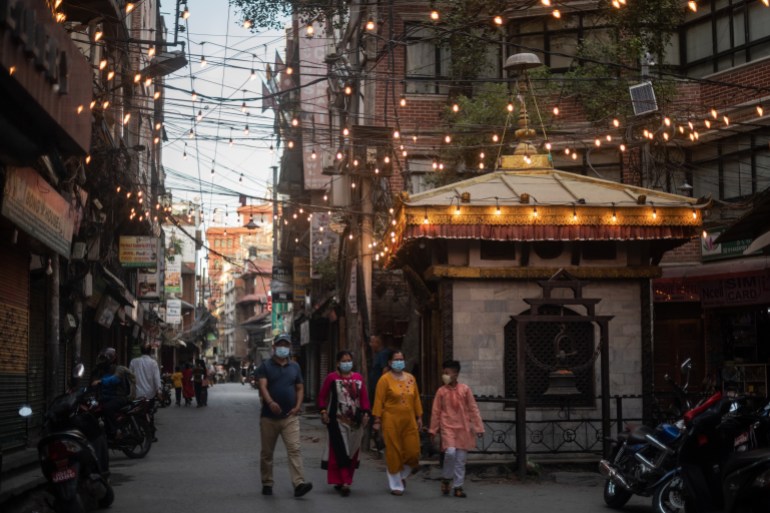
Sobhraj alleges that Knippenberg, who he refers to as “my opposite party”, paid police officials and judges to keep him in jail. Knippenberg was knighted by the Dutch king last year for his dogged efforts in investigating Sobhraj and seeking justice for his victims and was a hired consultant on the Netflix series. Al Jazeera was told via the Dutch embassy in Delhi that Knippenberg was currently not “making any comments regarding The Serpent”.
Ganesh KC laughed when I asked him about Sobhraj’s allegations of bribes paid to get him convicted.
“Do you believe him?” Ganesh KC, who said he is familiar with what he calls Sobhraj’s “khurafati dimaag” (malicious mind), asked of Sobhraj’s allegations. “He wants media publicity because he wants to make big money. So many filmmakers, documentary makers, book writers and publishers are behind him. They all want to make money from his crime-celebrity life. So the police, criminal justice system are shown as fools. That’s how he has always been.”
The legal challenge that Sobhraj is preparing to mount against Nepal has nothing to do with the murder trial, the signature evidence presented against him or the alleged bribes.
Instead, to prove that he is innocent of the murders, he wants to show that he never entered Nepal before 2003. To do that he plans to challenge his conviction for entering the country on the forged passport of Bintanja. And according to Sobhraj, it all hinges on a date he is fixated on – April 7, 1975.
“In the [immigration case] chargesheet, they have said that I entered Nepal on April 7, 1975. It’s impossible … I was in Athens jail at that time because I had been arrested with a forged Japanese passport,” Sobhraj told Al Jazeera over a video call as he bent over and read from English translations he had commissioned of several Nepali legal documents.
“I’m very legal-minded and when I speak something, it’s based on facts,” he added sharply.
Sobhraj claims the immigration case is “false” and was used to show his presence in Nepal to convict him of the two murders. He is convinced that if he can prove he was not in the country on that date, the murder convictions cannot hold. Since he simply dismisses all evidence such as the handwriting samples, he claims there would be nothing else to prove his presence in Nepal in 1975. “They have nothing,” he repeated in an interview.
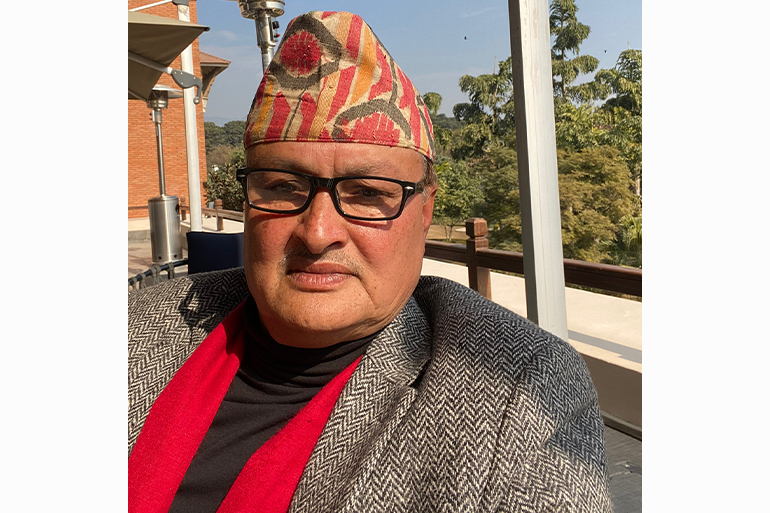
‘He’s a master of lies and deception’
I hadn’t heard from Sobhraj after 1997 until he contacted me last August from the Kathmandu jail to let me know that he would soon be released.
As always, he knew what was happening in India, had an opinion about it, and a solution.
He would call almost every week, speaking sometimes of India’s Prime Minister Narendra Modi and criticising him for revoking Kashmir’s special status, taking away the rights of India’s only Muslim-majority state accorded by the Indian constitution. Before this revocation, Kashmir had the right to its own constitution and to make laws excluding those concerning communications, foreign affairs and defence. “I’m completely against many of the things he’s doing,” Sobhraj said.
“Prior to my problem in Nepal, I was working for the Americans, the CIA against the Taliban and bin Laden,” he told me and then asked for the phone numbers of some of India’s top politicians and Bollywood actors.
But when an interview took place over two days last December he refused to answer questions about the dealings he alleges to have with security agencies and armed groups, his past or his crimes.
“I don’t want to speak about it, OK? You will see that in the documentary and in the book,” he said, and insisted that he only wanted to talk about his conviction in Nepal and his future plans.
He spoke with excitement about his intention to travel the world with a film crew to record his life story and hopes of securing Chinese financial backing to set up a news channel to cover Chinese business. “This one is my baby,” he said.
Changing tack, I asked him if he knew Bronzich and Carriere in Nepal.
“Listen, how I knew them when I never came to Nepal [before 2003]? What a stupid question!” he snapped.
And when I asked him about a diary entry Bronzich left behind mentioning “Alain Gautier,” he bristled.
“I don’t want you to make a blah, blah, blah [news report] like you want to do. Forget about the past. You only have to speak about Nepal,” he said.
“Why didn’t you challenge your conviction while you were in Nepal jail?” I asked.
“My dear,” he said with palpable irritation and impatience, before explaining that seeking a review would have meant delaying his release for decades. “That will be the most stupid thing to do.”
He kept returning to the case he says he wants to file against Nepal and the date – April 7, 1975.
He sent me the immigration chargesheet in Nepali and the English translations he had gotten done. The English document says Sobhraj entered Kathmandu on April 7, 1975, on Bintanja’s passport.
Ganesh KC laughed when I asked for comment on Sobhraj’s reasoning. He said it is clear in the Nepali chargesheet that the April 7 date refers to the date when Bintanja’s passport, on which Sobhraj had travelled to Nepal, was issued. It is not the date of Sobhraj’s travel to Nepal. The English translation is incorrect about the date’s significance. “He’s a master of lies and deception,” Ganesh KC said, matter of factly.
Nepal Supreme Court lawyer Ananta Raj Luitel, who has written a book about Sobhraj in Nepalese, confirmed that the date Sobhraj thinks is his trump card to establish he was not in Nepal – and is therefore innocent of the murders – is the date when Bintanja’s passport was issued.
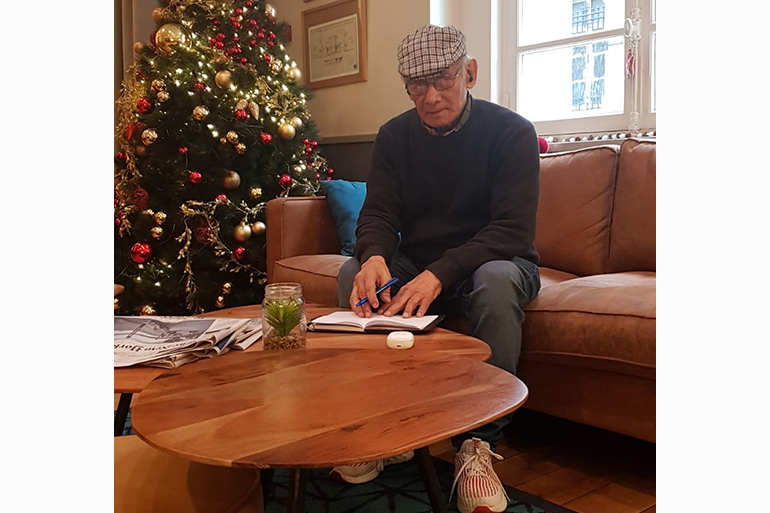
Closure
In the coastal Indian state of Goa, a statue of Sobhraj sits on the balcony of O’Coqueiro, the restaurant where he was arrested in 1986.
For Ganesh KC, Sobhraj’s notoriety has stamped out the stories of his many victims.
“He would destroy their identity,” said Ganesh KC, referring to the theft of people’s documents, and how murder victims were stripped and burned.
Ganesh KC believes Sobhraj only stands to gain from any media attention.
“Media, filmmakers, book writers, whether working for money or fame, all seem to be working for Charles. This is the vidambana [irony],” Ganesh KC warned.
Ganesh KC said that in 2004, after Sobhraj was convicted of Bronzich’s murder, he received a letter from her father. “He [Bronzich’s father] was almost 85 at that time, overwhelmed that his daughter’s soul would have got peace with Charles Sobhraj behind bars,” Ganesh KC recalled.
Kane, too, received a letter, in April 2021, from a man in the United Kingdom whose aunt had died in Goa in the seventies.
“He sort of said, ‘Do you know anything about this? My aunt died in very mysterious circumstances and she was cremated before we knew about it. … We think that Charles Sobhraj was behind that.’ You know, this family was clearly in anguish,” Kane said.
“My heart goes out to people who clearly had loved ones [go] missing at that age who were travelling, you know, in a kind of hippie-like way, if I can call it that, and then who were never heard from [again].” What people want, she added, is “closure”.
A sense of justice prevailed for the families of the victims while Sobhraj was in jail, she believes. “I wonder how these families feel now that Sobhraj is free.”
Sobhraj will be 80 next year. His hair is now white and has receded to settle over his ears.
“People say I look 68. I still have 10 good, active years,” he said with glee over the phone. But back in January, when he sent me a photograph of him sitting next to a Christmas tree in Paris, he captioned it, “The ugly guy.”